GEMS-2
(Last updated 1/4/09)
Topaz, or aluminum fluorosilicate.
Al2(F,OH)2SiO4, is one of the hardest minerals, ranking an 8 on
the Mohs hardness scale after diamond (10) and corundum (9). It
is also a fairly common mineral, and single crystals weighing
hundreds of pounds have been found. Today the majority of topaz
comes from Brazil; other significant deposits are found in Nigeria,
the Russian Urals, Australia, and the United States, with smaller
deposits in many other countries around the world. Although most
topaz is colorless or pale blue, natural topaz does come in a
number of other colors as well, including browns, yellowish- to
reddish-oranges ("precious" and "imperial"
topaz), yellows, pinks, reds, and greens. In natural topaz such
colors are produced primarily by trace amounts of iron and/or
chromium that, in the topaz crystal structure, act as "color
centers" by "trapping" electrons. However, the
color in the majority of natural topaz is pale and generally unstable
(eg, fading on exposure to sunlight) so that almost all of the
colored topaz used in jewelry today is generated from colorless
(white) topaz by a variety of different physical treatments (most
only very recently developed) that can produce a wide spectrum
of intense and permanent colors.
A pair of 0.5ct 5mm round white
(colorless/silver) topaz studs in s/s (left), and a 29ct(!) 19x16.5mm
oval modified Portuguese cut natural champagne colored topaz (right)
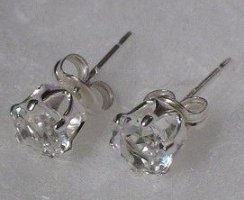
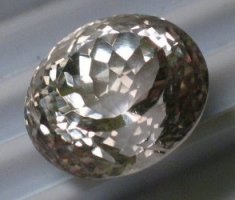 A 4.2ct 12.5x8mm pear shaped sky
blue topaz (left) and a 1.5ct 8x6mm oval Swiss blue topaz (right);
the "sky blue" color is produced by electron bombardment
of colorless topaz followed by heating, the popular "Swiss
blue" by using neutron bombardment
A 4.2ct 12.5x8mm pear shaped sky
blue topaz (left) and a 1.5ct 8x6mm oval Swiss blue topaz (right);
the "sky blue" color is produced by electron bombardment
of colorless topaz followed by heating, the popular "Swiss
blue" by using neutron bombardment
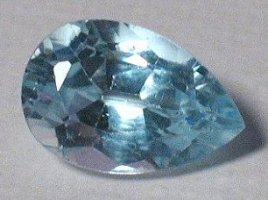
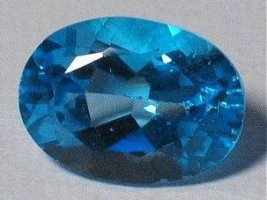 Pictured below are a 2.75ct 10x8mm
oval quantum cut pink topaz (left) - one of several colors that
can be produced by a process called vapor diffusion (of a metal
ion into the surface layer of a colorless topaz); and a pair of
1.5ct 8x6mm checkerboard top oval cut "mystic fire"
topaz (right) in 14kt gold leverbacks - one of several "colors"
produced by a process called vapor deposition (of a thin coating
of metal or metal oxide film onto the surface of colorless topaz).
Pictured below are a 2.75ct 10x8mm
oval quantum cut pink topaz (left) - one of several colors that
can be produced by a process called vapor diffusion (of a metal
ion into the surface layer of a colorless topaz); and a pair of
1.5ct 8x6mm checkerboard top oval cut "mystic fire"
topaz (right) in 14kt gold leverbacks - one of several "colors"
produced by a process called vapor deposition (of a thin coating
of metal or metal oxide film onto the surface of colorless topaz).
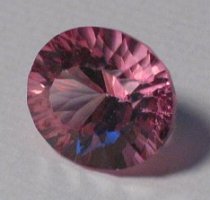
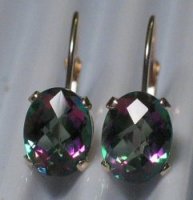
Quartz, or silicon dioxide - SiO2,
is the most common mineral in the Earth's crust. It is found in
nearly every geologic environment, and is a component of almost
every type of rock (a mixture of minerals), frequently as the
primary mineral. It is also one of the most varied minerals in
terms of the forms in which it can be found: cryptocrystalline
- in decorative stones such as the chalcedonies (eg, agates and
jaspers); microcrystalline - containing tiny but well-formed crystals
as found in aggregates like the druzes; and macrocrystalline.
Pure macrocrystalline quartz, or
rock crystal, is colorless and transparent; single specimens over
20 ft long and weighing over 50 tons have been found. Quartz is
also easily cut without cleaving, hence the production of crystal
balls for fortune tellers, crystal sculptures, etc. A large single
point crystal of colorless Brazilian rock crystal is shown below.
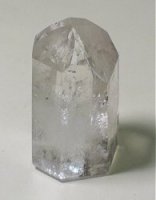 When Fe3+ is present in quartz as
an impurity, natural irradiation (probably by gamma rays from
the isotope potassium-40) can produce hole color centers (Fe4+)
to form the purple gemstone amethyst; if the same material is
exposed to higher temperatures during formation, the color centers
are destroyed and the result is yellow- to amber-colored citrine.
And because quartz usually contains about 0.01% Al3+, further
natural (or man-made) irradiation of any of the above crystalline
materials can also produce the AlO4- color centers that characterize
smoky quartz.
A 5.3ct 14x10mm oval Bolivian amethyst
(left) and a pair of 1.6ct 8mm round quantum/millenium cut citrines
set in heavy square post 14kt yg studs (right)
When Fe3+ is present in quartz as
an impurity, natural irradiation (probably by gamma rays from
the isotope potassium-40) can produce hole color centers (Fe4+)
to form the purple gemstone amethyst; if the same material is
exposed to higher temperatures during formation, the color centers
are destroyed and the result is yellow- to amber-colored citrine.
And because quartz usually contains about 0.01% Al3+, further
natural (or man-made) irradiation of any of the above crystalline
materials can also produce the AlO4- color centers that characterize
smoky quartz.
A 5.3ct 14x10mm oval Bolivian amethyst
(left) and a pair of 1.6ct 8mm round quantum/millenium cut citrines
set in heavy square post 14kt yg studs (right)
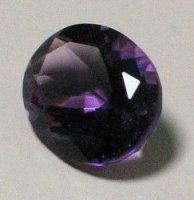
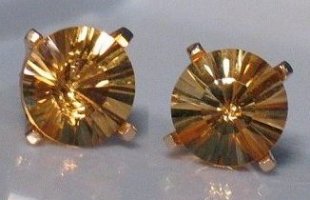 This 3ct 10x8mm emerald cut ametrine
(left), a phenomenon gemstone unique to the Anahí mine
of eastern Bolivia, naturallly contains both amethyst and citrine
in one specimen; a 31ct 20x18 emerald cut smoky quartz (right)
This 3ct 10x8mm emerald cut ametrine
(left), a phenomenon gemstone unique to the Anahí mine
of eastern Bolivia, naturallly contains both amethyst and citrine
in one specimen; a 31ct 20x18 emerald cut smoky quartz (right)
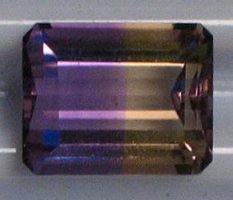
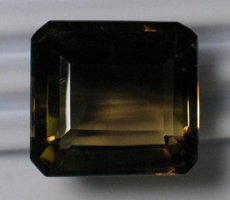 Some additional quartz examples
are shown below: a 4.0ct 12x10mm oval quantum cut rose quartz
(left) - the pink color is produced by charge transfer absorption
between Fe2+ and Ti4+; a 7.5ct 12x12mm princess cut yellow-green
"oro verde" quartz (center), rarely found in nature,
more commonly produced by irradiation of Brazilian rock crystal;
and a 4.0ct 14x10mm oval quantum cut leek-green prasiolite (right),
also called green amethyst, usually produced by heating interstitial
Fe2+-containing amethysts from Brazil and Arizona, but recently
found in nature at very high elevations in Bolivia, and in a combination
with amethyst and milky quartz (called amegreen) in Malawi
Some additional quartz examples
are shown below: a 4.0ct 12x10mm oval quantum cut rose quartz
(left) - the pink color is produced by charge transfer absorption
between Fe2+ and Ti4+; a 7.5ct 12x12mm princess cut yellow-green
"oro verde" quartz (center), rarely found in nature,
more commonly produced by irradiation of Brazilian rock crystal;
and a 4.0ct 14x10mm oval quantum cut leek-green prasiolite (right),
also called green amethyst, usually produced by heating interstitial
Fe2+-containing amethysts from Brazil and Arizona, but recently
found in nature at very high elevations in Bolivia, and in a combination
with amethyst and milky quartz (called amegreen) in Malawi
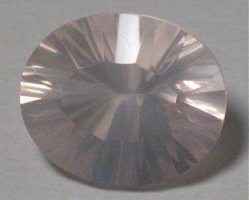
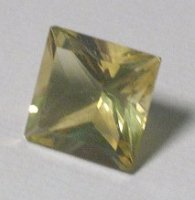
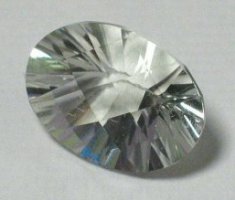 Crypto- and micro-crystalline quartz
materials have also been used as gemstones since ancient times.
Although they are valued much less highly today than in the past,
these materials are still being cut and polished as cabochons
(cabs) for use in jewelry (see Wire-wrapped
Jewelry).
One of the most commonly used microcrystalline
forms of quartz is called chalcedony (kal-sid-ney), a tough and
compact type of chert that forms rounded crusts or rinds in volcanic
and sedimentary rocks. Chalcedony comes in many varieties, including
carnelian, aventurine, onyx, sard, sardonyx, bloodstone, chrysoprase,
agate, jasper, and petrified wood. Chalcedony is widely distributed,
but commercial production comes primarily from Brazil, Africa,
and the United States.
Agate, one of the best known forms
of chalcedony, is translucent or completely transparent, but can
contain opaque inclusions of other minerals as in moss agate (left),
or can be conspicuously color-banded (usually with other minerals)
in adjacent layers, as in the mostly transparent eye agate slice
(right) from Malawi.
Crypto- and micro-crystalline quartz
materials have also been used as gemstones since ancient times.
Although they are valued much less highly today than in the past,
these materials are still being cut and polished as cabochons
(cabs) for use in jewelry (see Wire-wrapped
Jewelry).
One of the most commonly used microcrystalline
forms of quartz is called chalcedony (kal-sid-ney), a tough and
compact type of chert that forms rounded crusts or rinds in volcanic
and sedimentary rocks. Chalcedony comes in many varieties, including
carnelian, aventurine, onyx, sard, sardonyx, bloodstone, chrysoprase,
agate, jasper, and petrified wood. Chalcedony is widely distributed,
but commercial production comes primarily from Brazil, Africa,
and the United States.
Agate, one of the best known forms
of chalcedony, is translucent or completely transparent, but can
contain opaque inclusions of other minerals as in moss agate (left),
or can be conspicuously color-banded (usually with other minerals)
in adjacent layers, as in the mostly transparent eye agate slice
(right) from Malawi.
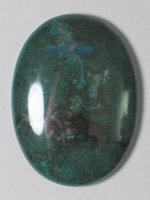
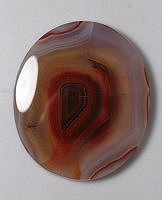 Onyx is a striped variety of agate;
it has a number of different descriptions, but a material with
alternating black and white bands (left) is the classic one. Lace
agates, illustrated by blue lace (center) from Namibia and crazy
lace (right) from Mexico, are noted for the delicate designs formed
by their characteristic bands.
Onyx is a striped variety of agate;
it has a number of different descriptions, but a material with
alternating black and white bands (left) is the classic one. Lace
agates, illustrated by blue lace (center) from Namibia and crazy
lace (right) from Mexico, are noted for the delicate designs formed
by their characteristic bands.
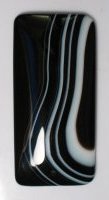
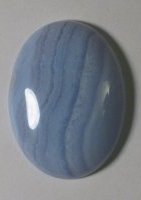
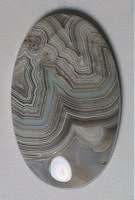 Jasper, an opaque variety of chalcedony,
means "spotted stone"; it occurs in all colors, but
most often in shades of brown, grayish blue, red, yellow, and
green. Like agate, jaspers are described by a variety of trade
names that number well over a hundred; these are usually based
on characteristic patterns, eg, the orbicular ocean jasper (left)
from northwest Madagascar and leopardskin jasper (center left),
and/or by geographic origin. Many of the finest jaspers are called
"porcelain" (very hard, so they take a high polish)
or "picture", and some of the best of these come from
the Northwest: Morrisonite (center right), from a ranch in the
Owyhee River canyon in eastern Oregon, is one of the best known;
Biggs jasper (right), from the Columbia River Gorge, is also very
popular.
Jasper, an opaque variety of chalcedony,
means "spotted stone"; it occurs in all colors, but
most often in shades of brown, grayish blue, red, yellow, and
green. Like agate, jaspers are described by a variety of trade
names that number well over a hundred; these are usually based
on characteristic patterns, eg, the orbicular ocean jasper (left)
from northwest Madagascar and leopardskin jasper (center left),
and/or by geographic origin. Many of the finest jaspers are called
"porcelain" (very hard, so they take a high polish)
or "picture", and some of the best of these come from
the Northwest: Morrisonite (center right), from a ranch in the
Owyhee River canyon in eastern Oregon, is one of the best known;
Biggs jasper (right), from the Columbia River Gorge, is also very
popular.
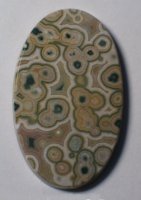
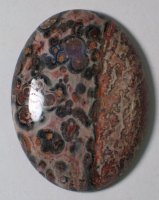
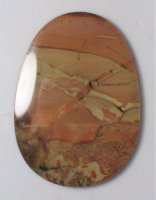
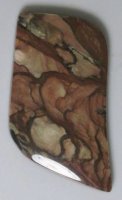
Opal, like quartz, is composed of
silicon dioxide containing up to 30% water (but usually 5-10%)
as a hardened hydrated silica gel - SiO2.n(H2O). Opal is considered
a mineraloid because it does not have a crystalline structure
- but it can possess structure nonetheless. Random chains of silicon
and oxygen are packed into extraordinarily tiny spheres (as small
as 0.001mm in diameter) composed of the mineral cristobalite (a
high temperature polymorph of SiO2). In most opals - called Common
Opal (or potch), these spheres are widely variable in size and
spatial distribution/concentration. However in some opals - called
Precious Opal, there are organized pockets or regions that contain
spheres of approximately equal size. Each of these pockets diffracts
light at a characteristic wavelength, producing a different color
with a different intensity, depending on the angle from which
the viewer observes it. These flashes of color, more properly
called "schiller" or "opalescence," make Precious
Opal an attractive and valued gemstone.
Precious Opal is divided descriptively
into dozens of varieties. Among the most commonly used terms are
black (although most of these are dark grey blue, or green) and
white (also tans and other light colors) - where the name indicates
the background color of the opal; boulder - opals with a dark
base and high density, usually resembling a rounded pebble; and
crystal, jelly, and harlequin - describing opals that are translucent
to transparent. Today most precious opals come from sites in Australia,
eg, Andamooka, Coober Pedy (white, crystal), Lightning Ridge (black),
Mintabie, White Cliffs, and Yowah (boulder), as well as from deposits
in Slovakia, Brazil, and Mexico. Many sites in the western US,
eg, Nevada, Idaho, Oregon, and California, also produce gem quality
opal.
A 12x10mm oval Lightning Ridge opal
triplet (left; such triplets consist of a very thin slice of natural
opal sandwiched between a dark rigid backing (eg, of ironstone,
the natural opal matrix) and a clear quartz cap, and an 18x13mm
oval mosaic opal triplet (right; the middle layer consists of
small pieces of sliced opal glued to the backing); both show the
opal's characteristic flashes of color
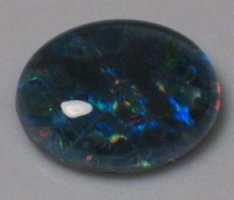
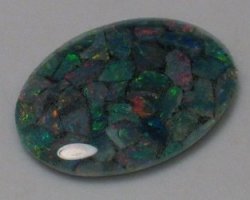 Another distinctive type of opal,
fire opal, generally shows no play of color, but diffraction produces
an intense uniform color in the stone, usually bright yellow to
dark reddish-orange, or even cherry red. Although most are milky
and turbid, fire opals of the best quality are clear, transparent,
and can be faceted. The result of ancient volcanic activity, most
fire opals come frome Mexico, which produces yellow-orange to
red colored gems, and Brazil, which produces mostly bright yellows,
but significant deposits are also found in Guatemala, the western
United States, and Australia.
A pair of 0.5ct 6mm round diamond
cut Mexican fire opals (left) in gold leverbacks, and a 3.0ct
cherry fire opal (right) from a new find in eastern Oregon.
Another distinctive type of opal,
fire opal, generally shows no play of color, but diffraction produces
an intense uniform color in the stone, usually bright yellow to
dark reddish-orange, or even cherry red. Although most are milky
and turbid, fire opals of the best quality are clear, transparent,
and can be faceted. The result of ancient volcanic activity, most
fire opals come frome Mexico, which produces yellow-orange to
red colored gems, and Brazil, which produces mostly bright yellows,
but significant deposits are also found in Guatemala, the western
United States, and Australia.
A pair of 0.5ct 6mm round diamond
cut Mexican fire opals (left) in gold leverbacks, and a 3.0ct
cherry fire opal (right) from a new find in eastern Oregon.
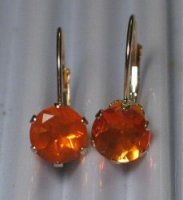
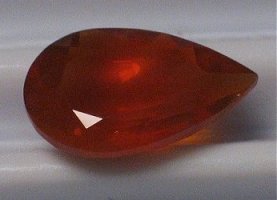
The feldspar group has at least
40 mineral members, although only nine are common; these few,
however, make up over 50% of the Earth's crust. The group is divided
into the isostructural plagioclase minerals, with the general
formula sodium calcium aluminum silicate - (Na,Ca)Al(1-2)Si(3-2)O8
(the more Ca, the more Al and the less Si), and the K-spars (potassium
feldspars), structural polymorphs of potassium aluminum silicate
- KAlSi3O8. Two plagioclase members can provide gemstones - sodium-rich
oligoclase (Na=90-70%, Ca=10-30%), more commonly known as sunstone,
and calcium-rich labradorite (Ca=50-70%, Na=50-30%). Among the
K-spars, the minerals microcline and orthoclase provide the gemstones
known as amazonite and moonstone, respectively.
Labradorite, found on its namesake
peninsula, in Madagascar, Australia, Russia, Finland, and the
US, is normally a dark, dull looking mineral until viewed from
the proper angle, at which point a play of light called "schiller",
or "labradorescence", appears on its surface, as in
the 25x18mm oval cabochon below (left). The color displayed can
range from yellows and oranges thru greens to blues and violets;
and some unusual specimens display many colors simultaneously,
as in the 25x18mm oval cab (center) and the freeform cab of Spectrolite
(right), a particularly high grade of labradorite found in Finland.
The colors are produced by refraction of light from the stone's
internal lamellar structure, formed when chemical mixtures of
closely related feldspars that are compatible at high temperatures
separate out into layers as the solution cools to form the stone.
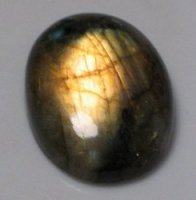
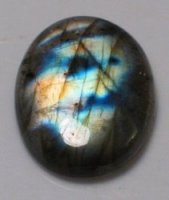
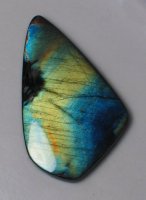 Sunstone (sometimes called aventurine
feldspar), an orange to reddish-brown mineral, also displays schiller,
or "aventurescence", most often originating from inclusions
of hematite or goethite; found mainly in India, Norway, Canada,
Russia, and the US, it is usually cut as cabochons. However, in
rare instances sunstones can be transparent, and an unusual material
from southeastern Oregon that also contains included platelets
of copper comes in a wide range of colors, from colorless through
pale yellow, red, and green to deep blue. And recently, another
Oregon deposit with an extremely high copper content (ca 200 ppm)
was found that produces deep orange-red stones like this 0.85ct
7x5mm emerald cut beauty.
Sunstone (sometimes called aventurine
feldspar), an orange to reddish-brown mineral, also displays schiller,
or "aventurescence", most often originating from inclusions
of hematite or goethite; found mainly in India, Norway, Canada,
Russia, and the US, it is usually cut as cabochons. However, in
rare instances sunstones can be transparent, and an unusual material
from southeastern Oregon that also contains included platelets
of copper comes in a wide range of colors, from colorless through
pale yellow, red, and green to deep blue. And recently, another
Oregon deposit with an extremely high copper content (ca 200 ppm)
was found that produces deep orange-red stones like this 0.85ct
7x5mm emerald cut beauty.
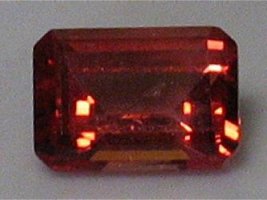 Another feldspar that displays colors
similar to Oregon sunstone appeared on the market in 2002, as
in this pair of red 0.35ct 5mm round cut stones (left), the green
1.85ct 9x7mm emerald cut (center; note the reddish color in its
lower section), and this 2.0ct 10x8mm deep green oval (right;
also with a tinge of red at the very bottom). Called andesine-labradorite
by JTV, the prinary seller, after much speculation and laboratory
analysis it has been determined that these stones were produced
mainly by surface diffusion (possibly with copper/iron) into gem
quality yellow labradorite from Mexico (and/or possibly China),
although there is still some uncertainty about the origin and
nature of all such stones.
Another feldspar that displays colors
similar to Oregon sunstone appeared on the market in 2002, as
in this pair of red 0.35ct 5mm round cut stones (left), the green
1.85ct 9x7mm emerald cut (center; note the reddish color in its
lower section), and this 2.0ct 10x8mm deep green oval (right;
also with a tinge of red at the very bottom). Called andesine-labradorite
by JTV, the prinary seller, after much speculation and laboratory
analysis it has been determined that these stones were produced
mainly by surface diffusion (possibly with copper/iron) into gem
quality yellow labradorite from Mexico (and/or possibly China),
although there is still some uncertainty about the origin and
nature of all such stones.
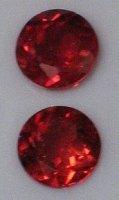
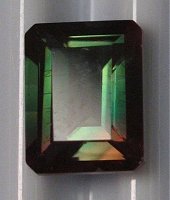
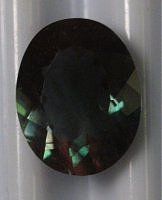 Amazonite, the gem variety of microcline
feldspar, is usually polished as a cabochon (left); specimens
can display schiller. Top quality moonstones, composed of orthoclase,
are usually colorless and transparent, although specimens can
also be translucent, opaque white, yellow, gray, orange, or even
peach colored. However some moonstones, like those from southern
India or Sri Lanka, can have lamellar inclusions of albite (NaAlSi2O8)
that produce a schiller called "adularescence", a glow
that seems to float within the stone, as in the 8x6 oval moonstone
cabochons set in white gold studs (center); thin layers of albite
cause blue schiller, thicker layers white. There is also a transparent
gem, primarily from Madagascar, that is marketed as "rainbow
moonstone"; it also shows schiller, but with a spectrum of
colors, as in this 12x9mm oval cabochon (right) - from a mineralogical
standpoint, this "moonstone" is actually a labradorite.
Amazonite, the gem variety of microcline
feldspar, is usually polished as a cabochon (left); specimens
can display schiller. Top quality moonstones, composed of orthoclase,
are usually colorless and transparent, although specimens can
also be translucent, opaque white, yellow, gray, orange, or even
peach colored. However some moonstones, like those from southern
India or Sri Lanka, can have lamellar inclusions of albite (NaAlSi2O8)
that produce a schiller called "adularescence", a glow
that seems to float within the stone, as in the 8x6 oval moonstone
cabochons set in white gold studs (center); thin layers of albite
cause blue schiller, thicker layers white. There is also a transparent
gem, primarily from Madagascar, that is marketed as "rainbow
moonstone"; it also shows schiller, but with a spectrum of
colors, as in this 12x9mm oval cabochon (right) - from a mineralogical
standpoint, this "moonstone" is actually a labradorite.
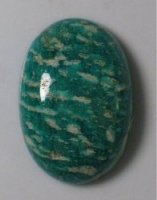
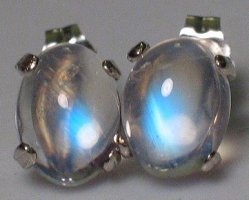
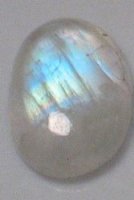 Go to Gems-1 | Go to Gems-3 | Wire-wrapped Jewelry | Return
to Home Page
Go to Gems-1 | Go to Gems-3 | Wire-wrapped Jewelry | Return
to Home Page






































